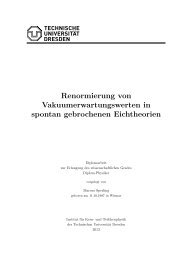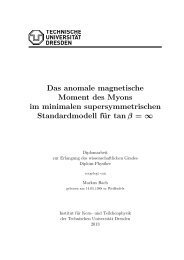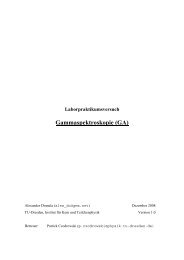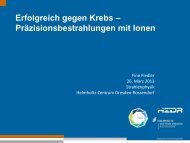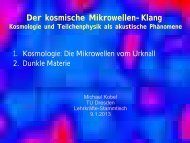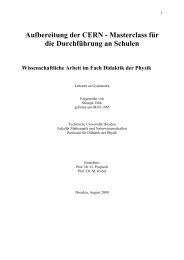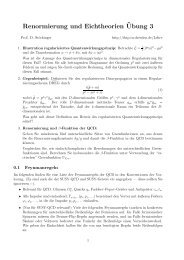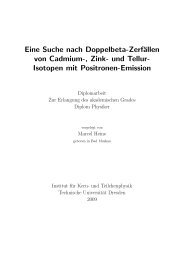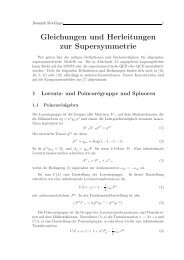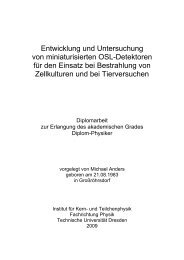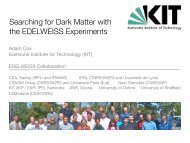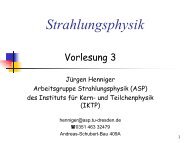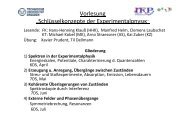a design study for a cobra upgrade to - Institut für Kern- und ...
a design study for a cobra upgrade to - Institut für Kern- und ...
a design study for a cobra upgrade to - Institut für Kern- und ...
Create successful ePaper yourself
Turn your PDF publications into a flip-book with our unique Google optimized e-Paper software.
98 B SECOND APPENDIX<br />
B.2 Geant4<br />
Geant4 is an object-oriented <strong>to</strong>olkit <strong>for</strong> the simulation of the passage of<br />
particles through matter, written in C++. It provides a realistic reproduction<br />
of physical processes <strong>for</strong> an energy region from 250 eV up <strong>to</strong><br />
a few GeV. The necessary cross sections <strong>for</strong> the simulations are interpolated<br />
from s<strong>to</strong>red values in evaluated databases. The final state depends<br />
on the angle and energy distributions and will be calculated with<br />
the corresponding theoretical model or interpolated from the database<br />
[44].<br />
A main method with two <strong>to</strong>olkit classes (G4Runmanager and<br />
G4UImanager) and three classes, which are derived from<br />
<strong>to</strong>olkit classes (G4Detec<strong>to</strong>rconstruction, G4PhysicsList and<br />
G4PrimaryGenera<strong>to</strong>rAction) are required <strong>for</strong> building a simulation.<br />
The G4Runmanager controls the flow of the program. It manages<br />
the initialisation procedures like detec<strong>to</strong>r construction, definition of<br />
particles and physics processes or initialisation of primary particles.<br />
In the user initialised class Detec<strong>to</strong>rConstruction, the geometry and<br />
material of the detec<strong>to</strong>r are defined by the user.<br />
In the PhysicsList, the user defines the particles and physical processes,<br />
which shall be regarded. The initial state of the event is defined with<br />
the PrimaryGenera<strong>to</strong>rAction. This implies the particle type, energy, position,<br />
direction and number of initialised particles. A RUN is defined<br />
as a set of events. The user has control at the Begin and End of each run<br />
(class RunAction), the Begin and End of each event (class EventAction),<br />
the begin and End of each track (class TrackingAction) and at the End<br />
of each step (class SteppingAction). A HIT is a record, track per track<br />
(and even step per step), of a set of user defined in<strong>for</strong>mation needed <strong>to</strong><br />
simulate and analyse the detec<strong>to</strong>r response. Only interactions in volumes,<br />
specified as sensitive detec<strong>to</strong>rs can be handled as hits and be<br />
s<strong>to</strong>red in the HitsCollection. The HitsCollection is printed at the end of<br />
event (via the method TrackerSD::EndOfEvent()), <strong>und</strong>er the control of<br />
the command:/hits/verbose 1. A visualisation of the event is possible<br />
with the G4VisManager. Used visualisation systems are OpenGL,<br />
Heprep or Dawn. Geant4 applications can run in batch mode, where<br />
macro commands, being read at the beginning of a run, can be used.<br />
An interactive mode, driven by command lines or via a graphical user<br />
interface is also possible. [48]<br />
VENOM is the Cobra simulation framework, first developed by H.<br />
Kiel [8] and re<strong>design</strong>ed by J. Wilson and B. Morgan [53]. It is a



